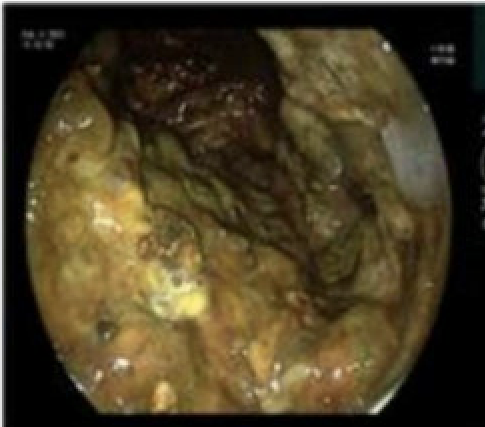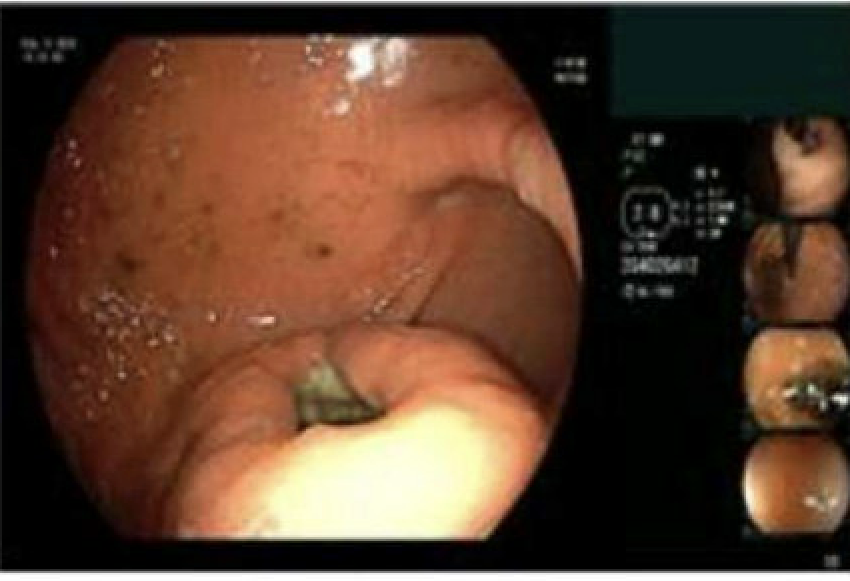Tuesday Poster Session
Category: Stomach and Spleen
P6365 - A Case of Gastrocolic Fistula Turning Out to Be Gastric Adenocarcinoma
Tuesday, October 28, 2025
10:30 AM - 4:00 PM PDT
Location: Exhibit Hall
- OA
Osama Asad, MD
University of Missouri-Kansas City
Kansas City, MO
Presenting Author(s)
Rajiv Chhabra, MD1, Ifrah Fatima, MD1, Mir Zulqarnain, DO1, Osama Asad, MD2
1University of Missouri - Kansas City School of Medicine, Kansas City, MO; 2UMKC, Kansas City, MO
Introduction: The development of a fistula between segments of the gastrointestinal tract is a rare occurrence in malignant disease. Gastrocolic fistula (GCF) can be caused by both benign and malignant conditions. Malignant gastrocolic fistula is most associated with adenocarcinoma of the transverse colon. Gastric adenocarcinoma causing a fistulous opening into the colon is rare.
Case Description/
Methods: An 80-year-old female presented following a motor vehicle accident. Review of systems revealed a one-month history of dark stools, nausea, vomiting, diarrhea, and a 10-pound weight loss over the past year. Initial labs revealed severe anemia (Hb 4.4 g/dL). CT abdomen demonstrated a large, circumferential, deeply ulcerated mass in the gastric antrum and pylorus with a direct fistulous communication to the adjacent transverse colon. Tumor markers were elevated (CEA 307.6 ng/mL, CA 19-9: 50 U/mL).
Esophagogastroduodenoscopy revealed a large ulcerated fistulous opening between the stomach and colon. The endoscope was easily advanced through the fistula into the colon. Diffuse ulceration was seen on both the gastric and colonic sides.
Biopsies from the lesion showed poorly differentiated adenocarcinoma with signet-ring features, favoring a gastric origin. Pancreaticobiliary origin could not be completely excluded. Given the patient’s advanced age and frailty, she was deemed not a candidate for curative treatment and was transitioned to hospice care.
Discussion: This case illustrates a rare presentation of GCF resulting from advanced gastric adenocarcinoma. Classic symptoms such as weight loss, feculent vomiting, and diarrhea may be absent, complicating early recognition. Imaging and endoscopy are critical in identifying fistulous tracts and obtaining tissue for diagnosis. The presence of signet-ring features portends a poor prognosis. Surgical resection remains the standard treatment; however, many patients present with advanced disease precluding curative options. This case highlights the importance of early suspicion, multidisciplinary evaluation, and individualized management in complex GI malignancies.

Figure: Fistulous opening in Mid Gastric Body

Figure: Ulceration in the Colon side
Disclosures:
Rajiv Chhabra indicated no relevant financial relationships.
Ifrah Fatima indicated no relevant financial relationships.
Mir Zulqarnain indicated no relevant financial relationships.
Osama Asad indicated no relevant financial relationships.
Rajiv Chhabra, MD1, Ifrah Fatima, MD1, Mir Zulqarnain, DO1, Osama Asad, MD2. P6365 - A Case of Gastrocolic Fistula Turning Out to Be Gastric Adenocarcinoma, ACG 2025 Annual Scientific Meeting Abstracts. Phoenix, AZ: American College of Gastroenterology.
1University of Missouri - Kansas City School of Medicine, Kansas City, MO; 2UMKC, Kansas City, MO
Introduction: The development of a fistula between segments of the gastrointestinal tract is a rare occurrence in malignant disease. Gastrocolic fistula (GCF) can be caused by both benign and malignant conditions. Malignant gastrocolic fistula is most associated with adenocarcinoma of the transverse colon. Gastric adenocarcinoma causing a fistulous opening into the colon is rare.
Case Description/
Methods: An 80-year-old female presented following a motor vehicle accident. Review of systems revealed a one-month history of dark stools, nausea, vomiting, diarrhea, and a 10-pound weight loss over the past year. Initial labs revealed severe anemia (Hb 4.4 g/dL). CT abdomen demonstrated a large, circumferential, deeply ulcerated mass in the gastric antrum and pylorus with a direct fistulous communication to the adjacent transverse colon. Tumor markers were elevated (CEA 307.6 ng/mL, CA 19-9: 50 U/mL).
Esophagogastroduodenoscopy revealed a large ulcerated fistulous opening between the stomach and colon. The endoscope was easily advanced through the fistula into the colon. Diffuse ulceration was seen on both the gastric and colonic sides.
Biopsies from the lesion showed poorly differentiated adenocarcinoma with signet-ring features, favoring a gastric origin. Pancreaticobiliary origin could not be completely excluded. Given the patient’s advanced age and frailty, she was deemed not a candidate for curative treatment and was transitioned to hospice care.
Discussion: This case illustrates a rare presentation of GCF resulting from advanced gastric adenocarcinoma. Classic symptoms such as weight loss, feculent vomiting, and diarrhea may be absent, complicating early recognition. Imaging and endoscopy are critical in identifying fistulous tracts and obtaining tissue for diagnosis. The presence of signet-ring features portends a poor prognosis. Surgical resection remains the standard treatment; however, many patients present with advanced disease precluding curative options. This case highlights the importance of early suspicion, multidisciplinary evaluation, and individualized management in complex GI malignancies.

Figure: Fistulous opening in Mid Gastric Body

Figure: Ulceration in the Colon side
Disclosures:
Rajiv Chhabra indicated no relevant financial relationships.
Ifrah Fatima indicated no relevant financial relationships.
Mir Zulqarnain indicated no relevant financial relationships.
Osama Asad indicated no relevant financial relationships.
Rajiv Chhabra, MD1, Ifrah Fatima, MD1, Mir Zulqarnain, DO1, Osama Asad, MD2. P6365 - A Case of Gastrocolic Fistula Turning Out to Be Gastric Adenocarcinoma, ACG 2025 Annual Scientific Meeting Abstracts. Phoenix, AZ: American College of Gastroenterology.
